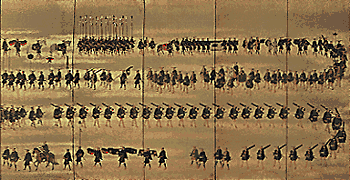 |
Ishikawa Prefectural Museum
The name Kanazawa is derived from the following story: A peasant named Imohori Togoro made his living digging potatoes. He washed gold dust from the potatoes into a well, now called Kinjo Reitaku, so the area was named Kanazawa, meaning 'marsh of gold.' About 500 years ago the Ikko sect of Buddhism set up a religious goverment with its center at the Kanazawa Gobo temple, which later became the site of Kanazawa Castle. The temple was destroyed by an army led by Oda Nobunaga in 1580. Maeda Toshiie, one of his retainers, entered into Kanazawa in 1583, built a castle in its stead and ruled the district as the lord possessing the largest fief in Japan. He is known for producing a million koku of rice annually (one koku equals five bushels). The Maeda lords especially fostered arts and crafts, and Kanazawa became a cultural center like Tokyo (then known as Edo) and Kyoto. After the Meiji Restoration in 1868 Kanazawa became the capital of Ishikawa Prefecture, and has flourished as the hub of political, economic, educational, and cultural activities in the Hokuriku District. | |